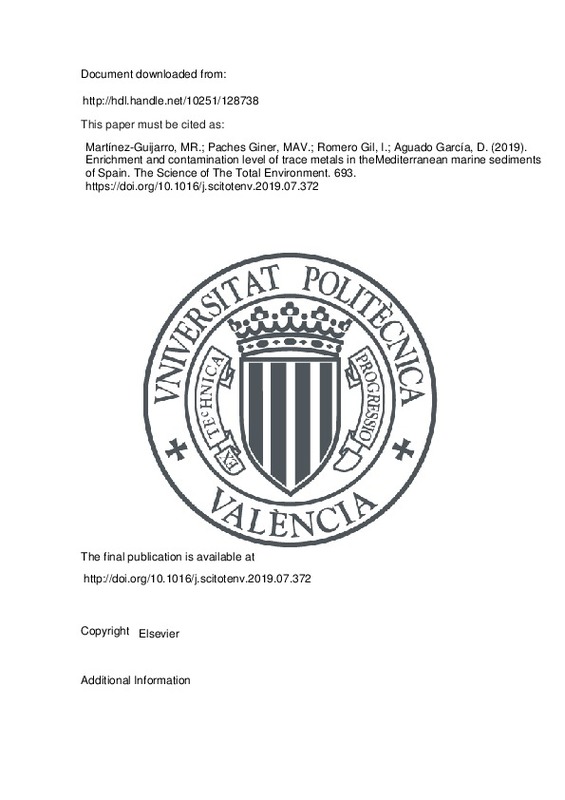JavaScript is disabled for your browser. Some features of this site may not work without it.
Buscar en RiuNet
Listar
Mi cuenta
Estadísticas
Ayuda RiuNet
Admin. UPV
Enrichment and contamination level of trace metals in theMediterranean marine sediments of Spain
Mostrar el registro sencillo del ítem
Ficheros en el ítem
| dc.contributor.author | Martínez-Guijarro, Mª Remedios
|
es_ES |
| dc.contributor.author | Paches Giner, Maria Aguas Vivas
|
es_ES |
| dc.contributor.author | Romero Gil, Inmaculada
|
es_ES |
| dc.contributor.author | Aguado García, Daniel
|
es_ES |
| dc.date.accessioned | 2019-10-16T20:00:54Z | |
| dc.date.available | 2019-10-16T20:00:54Z | |
| dc.date.issued | 2019 | es_ES |
| dc.identifier.issn | 0048-9697 | es_ES |
| dc.identifier.uri | http://hdl.handle.net/10251/128738 | |
| dc.description.abstract | [EN] Coastal ecosystems are heavily polluted by human activities. These pollutants reach the aquatic environment and accumulate in the sediment. Among the chemical pollutants, metals represent a notable hazard since they are not biodegradable and have the capability to bioaccumulate, resulting in toxic effects in both the short and long term. In this study, the content of metals and As in marine sediments of the Spanish Mediterranean coast was determined. A total of four annual sampling campaigns were carried out along the Valencian Community coastline, where the presence of eight trace elements (Cr, Cd, Ni, Pb, Cu, Hg, Zn and As) was determined. In this area, the presence of the contaminants is due to both natural and anthropogenic sources. The results obtained allowed, first, to establish nearness Reference Values of the area under study, second, to use several pollution indices (Contamination Factor, Enrichment Factor, Geoaccumulation Factor, Nemerow Pollution Index, and Modified Pollution Index) to determine contamination levels in the area, and finally to select the best index to apply in this coastal zone. The best indices to use in this region are EF and MPI since both take into consideration the natural contributions of the elements studied. The results revealed that according to the index used only two studied zones are classified as Heavily and Severely polluted. The remaining zones (between 25 and 29%) were classified as Moderately or Moderately to Heavily polluted and most of the zones (63% to 100%) were classified as Unpolluted/Low Polluted and Unpolluted/Slightly Polluted. The outcomes obtained with this work indicate that in general, the Valencian coast does not present significant levels of pollution due to the studied trace elements. | es_ES |
| dc.language | Inglés | es_ES |
| dc.publisher | Elsevier | es_ES |
| dc.relation.ispartof | The Science of The Total Environment | es_ES |
| dc.rights | Reconocimiento - No comercial - Sin obra derivada (by-nc-nd) | es_ES |
| dc.subject | Metals | es_ES |
| dc.subject | Sediment contamination | es_ES |
| dc.subject | Pollution index | es_ES |
| dc.subject | Background Enrichment Indices | es_ES |
| dc.subject | Integrated pollution indices | es_ES |
| dc.subject | Environmental impact | es_ES |
| dc.subject.classification | TECNOLOGIA DEL MEDIO AMBIENTE | es_ES |
| dc.title | Enrichment and contamination level of trace metals in theMediterranean marine sediments of Spain | es_ES |
| dc.type | Artículo | es_ES |
| dc.identifier.doi | 10.1016/j.scitotenv.2019.07.372 | es_ES |
| dc.rights.accessRights | Abierto | es_ES |
| dc.contributor.affiliation | Universitat Politècnica de València. Departamento de Ingeniería Hidráulica y Medio Ambiente - Departament d'Enginyeria Hidràulica i Medi Ambient | es_ES |
| dc.description.bibliographicCitation | Martínez-Guijarro, MR.; Paches Giner, MAV.; Romero Gil, I.; Aguado García, D. (2019). Enrichment and contamination level of trace metals in theMediterranean marine sediments of Spain. The Science of The Total Environment. 693. https://doi.org/10.1016/j.scitotenv.2019.07.372 | es_ES |
| dc.description.accrualMethod | S | es_ES |
| dc.relation.publisherversion | http://doi.org/10.1016/j.scitotenv.2019.07.372 | es_ES |
| dc.type.version | info:eu-repo/semantics/publishedVersion | es_ES |
| dc.description.volume | 693 | es_ES |
| dc.identifier.pmid | 31362235 | |
| dc.relation.pasarela | S\392041 | es_ES |







![[Cerrado]](/themes/UPV/images/candado.png)

